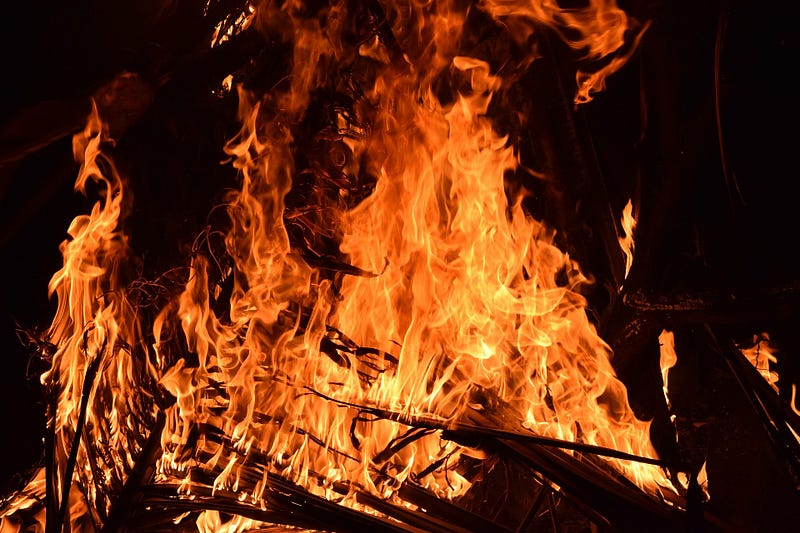Spontaneous Human Combustion: We Didn’t Start the Fire (Or Did We?)
By Kaelen Encarnacion, Biology and English, 2021

The door handle is still warm. The air smells of something acrid and burnt. The wallpaper is blackened and peeling, with trapped air half-forming bubbles underneath. Bits of ash and other nondescript debris float in the air and settle on every surface, threatening your lungs with every breath you take.
This scene is all too familiar and all too tragic. Firefighters and police officers survey the landscape searching for a source of ignition — a blown outlet, a recently-lit fireplace, a spilled bottle of alcohol, or even a discarded cigarette. In most circumstances, a cause is identified and, somberly, the case is closed.
But sometimes, no external source of ignition is found. And sometimes, there are no human remains, save for a pile of ashes and a limb. Everything outside the immediate vicinity remains untouched, even though the victim must have burned at least 1600 degrees Fahrenheit for several hours to be reduced to nothing but ash. This terrifying phenomenon is called “spontaneous human combustion,” or SHC.
This terrifying phenomenon is called “spontaneous human combustion,” or SHC.
Reports of this phenomenon have been recorded as early as the mid-17th century, with depictions in artwork dating from even earlier. However, SHC did not reach widespread public awareness until 1853, when Charles Dickens wrote about the death of a character by spontaneous combustion in his book, “Bleak House.” Since then, SHC has found its way into literary works by authors such as Mark Twain, Herman Melville, and Washington Irving.
Unfortunately, SHC is not only seen in old myths or works of fiction.
The first highly-publicized case was that of Mary Reeser, a 67-year old woman found burned to death in her apartment in St. Petersburg, Florida, in 1951. All that remained was her left foot, a piece of vertebrae, and a shrunken skull. Little else showed any fire damage besides the chair she was sitting in and a nearby electrical outlet.
Another famous case was that of Dr. John Irving Bentley, whose right foot was found in his bathroom in 1966, while his ashes were in the basement below after the fire burned a hole in the floor. It was initially speculated that he dropped hot ashes from his pipe onto his bathrobe, igniting the wooden matches he kept in his pocket; however, his pipe was later found beside his bed.
SHC has even been observed within the past decade, with the mysterious death of Michael Faherty in 2010, whose badly burnt body was found on its back with his head next to an open fireplace. The only damage was that sustained by the body, the floor beneath him, and the ceiling directly above. After thorough investigation, officials concluded that the fireplace was not the cause of the blaze.
With around 200 alleged cases reported worldwide and such little evidence to explain otherwise, “spontaneous human combustion” has become an official coroner’s verdict as the cause of death.
Over the past few centuries, many pseudoscientific explanations have sought attention in the wake of these “spontaneous” deaths.
Over the past few centuries, many pseudoscientific explanations have sought attention in the wake of these “spontaneous” deaths. Just a century ago, SHC was attributed to moral failing: the victim must have been an alcoholic who saturated his body with liquor and received divine punishment. Some other theories suggested SHC was caused by poltergeist activity, or by fabricated subatomic particles called “pyrotrons.”
Many scientists are unsurprisingly skeptical. While the human body’s most flammable components are methane gas and fatty tissues, its 60 percent water content makes it difficult to ignite. When analyzing the reported cases, a few common threads seem to emerge: many of the victims were elderly, close to a fire source, were last seen smoking or drinking, and there were no witnesses around. They could have easily suffered from a heart attack or stroke and would be incapacitated if their clothing caught fire.
This leads to the question of how the victims seemed to burn almost completely to ash while the surrounding area was untouched. The “wick effect,” a well-observed phenomenon tested with a dead pig wrapped in a blanket, is when a part of the victim’s clothing catches on fire and is sustained by the melted human fat it has soaked up. This turns the body into a morbid candle, where the clothing acts as the “wick” and human fat serves as the fuel source, creating a slow, potent burn.
While not every case of SHC is the same, its rarity, exclusivity to humans, and lack of scientific evidence all point to the verdict that the “spontaneity” in human combustion may just be smoke and mirrors.
DOI: 10.1007/s12024–016–9748–2
DOI: 10.1097/BCR.0b013e318239c5d7
